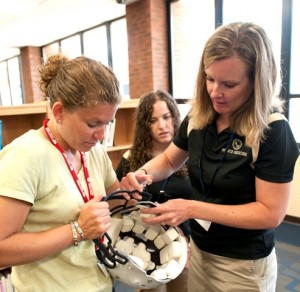It’s easy for fans to see an athletic injury happen: A pitcher tweaks his throwing arm, a forward pulls up limping or a running back stays on the field after a tackle.
The athletic trainers run out to check on the player and the fans start the guessing game. How serious is it? How long will they be on the disabled list? Who can be called up or signed to replace them?
Rarely do fans think about the athletic trainer, who often is the person making the decision as to whether the player can keep playing or needs further medical attention.
At Collinsville High School, the person making those calls is Amanda Baugher, the Kahoks’ certified athletic trainer.
“We work with the prevention, diagnosis and treatment of athletic injuries,” Baugher said.
According to the National Athletic Trainers’ Association, 47 states regulate athletic trainers and 46 of those states require athletic trainers to be certified.
Trainers in Illinois must take continuing education courses and renew their certification every two years, Baugher said. Hailing from tiny Grand Tower, Ill., Baugher earned a degree in physical education with a specialization in athletic training from Southern Illinois University Carbondale.
Sprains, ligament tears and concussions are more common than serious injuries at CHS, Baugher said. If an athlete suffers an injury, but says they can or want to keep playing, Baugher said there are functional tests the athlete does to test the injured area.
“You can put them through different testing to see if they’re able to do all their sport requires,” Baugher said.
Even with her training and knowledge, sometimes some extra information that does not come from tests plays into Baugher’s decisions.
“You have to know your athletes. Some tend to exaggerate. Some tend to push too much,” Baugher said. “I just have to make a judgment call to see if they’re safe to return.”
With 22 teams at CHS, getting to know each athlete can be difficult. Baugher relies on her 12 years of experience to learn the athletes quickly.
In the event she is not familiar with a player, Baugher said she works with the coaches to evaluate the injury. She is the one who will ultimately decide what to do, though.
Those 22 teams can make for a difficult decision for Baugher when, during the school year, there are multiple games in Collinsville on any given day and she is the only athletic trainer at CHS.
“Typically, there’s only one athletic trainer at the high school,” Baugher said. “I have to pick and choose based on highest risk.”
If an injury happens at an event she does not attend, she is available by phone. She does not, however, travel to away games, for the most part.
“We only travel with football primarily,” Baugher said. “We know when a team is going to another conference school, there’s going to be another [athletic trainer] there.”
An athletic trainer’s work starts before the players hit the playing surface. Baugher said she starts in the afternoon by spending a few hours in the training room, where she usually focuses on taping and wrapping the athletes.
She also is responsible for providing water for the teams, which she said she takes care of before school gets out.
After the final bell, Baugher is on the field at practices in case of injury. But that is not all she does for the Kahoks.
Baugher has been working with the teams at CHS to establish concussion programs.
“We’re doing pre-screenings this year to get a baseline for concussions,” Baugher said. “That’s a new program we’re working on here.”
Over the last several years, Baugher said she has worked with the girls basketball and soccer teams to implement prevention programs for ACL tears, which she said are prevalent in girl’s sports.
She also heads up the drug testing program that tests athletes all year long.
It is a lot of work and sometimes the conditions are not perfect, but Baugher said it is an enjoyable career.
“I’m not a big fan of working in the rain, but it happens. There’s also the indoor season which balances it out,” Baugher said. “It can be long hours, but it’s also fun to watch, especially when the kids are successful or when a kid has been injured and comes back.”




